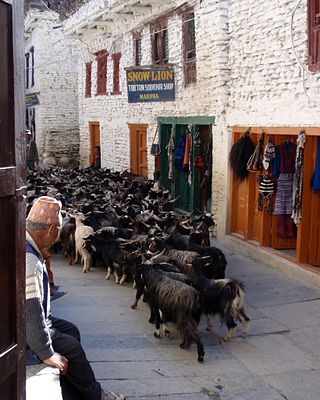Related Research Articles

Upper Mustang is an upper part of Mustang District, which is located in Nepal. The Upper Mustang was a restricted kingdom until 1992 which makes it one of the most preserved regions in the world, with a majority of the population still speaking traditional Tibetic languages. Tibetan culture has been preserved by the relative isolation of the region from the outside world. Life in Mustang revolves around tourism, animal husbandry and trade.

The Thakali are an ethnolinguistic Tibeto-Burman ethnic group of Nepal. The traditional area of the Thakali community is called Thak-sat-se or the Thak Khola region and lies in the Kali Gandaki River valley in the Mustang District, Gandaki Province in western Nepal. According to the 2001 census, the Thakali population of around 12,973 constituted only 0.06% of Nepal's population. By the 2011 Nepal census, there were 13,215 Thakali people in Nepal.

The Kali Gandaki Gorge or Andha Galchi is the gorge of the Kali Gandaki in the Himalayas in Nepal. By some sources, it may be one of the deepest gorges in the world.

Mustang District is one of the eleven districts of Gandaki Province and one of seventy-seven districts of Nepal which was a Kingdom of Lo-Manthang that joined the Federation of Nepal in 2008 after abolition of the Shah dynasty. The district covers an area of 3,573 km2 (1,380 sq mi) and in 2011 had a population of 13,452. The headquarters is located at Jomsom. Mustang is the fifth largest district of Nepal in terms of area.

Gurung, also known as Tamu Kyi or Tamu Bhāṣā, is a Sino-Tibetan language spoken by the Gurung people of Nepal. The total number of all Gurung speakers in Nepal was 227,918 in 1991 and 325,622 in 2011.

Tamang is a term used to collectively refer to a dialect cluster spoken mainly in Nepal, Sikkim, West Bengal (Darjeeling) and North-Eastern India. It comprises Eastern Tamang, Northwestern Tamang, Southwestern Tamang, Eastern Gorkha Tamang, and Western Tamang. Lexical similarity between Eastern Tamang and other Tamang languages varies between 81% and 63%. For comparison, lexical similarity between Spanish and Portuguese, is estimated at 89%.
Chhantyal is spoken by approximately 2,000 of the 10,000 ethnic Chhantyal in Nepal. Chhantyal is spoken in the Kali Gandaki River valley of Myagdi District; there are also ethnic Chantel in Baglung District (Ethnologue).

Lomanthang is a rural municipality in Mustang district in Gandaki Province of western Nepal. It is located at the northern end of the district, bordering the Tibet Autonomous Region of China to the north and Dalome rural municipality of Mustang in the south.

Jomsom, also known as Dzongsam, is the centre of Gharapjhong rural municipality in Mustang district and a former independent village development committee situated at an altitude of about 2,700 metres (8,900 ft) in Gandaki Province of western Nepal. The soaring peaks of Dhaulagiri and Nilgiri form a backdrop to the town straddling the Kali Gandaki River, which flows right through the centre of Jomsom. Along the banks of the Kali Gandaki, black fossilised stones called shaligram, considered as an iconic symbol and reminder of the god Vishnu in the Hindu culture, can be found. Such stones are believed to be found only in the Kali Gandaki, and are considered holy by Hindus.

Beni is a municipality and the district headquarters of Myagdi District in Gandaki Province, Nepal. Municipality was announced by merging the then Ratnechaur, Jyamrukot, Arthunge, Pulachaur, Singa village development committees since 18 May 2014.

Marpha is a village in Mustang District in the Dhawalagiri Zone of northern Nepal. At the time of the 1991 Nepal census it had a population of 1630 people living in 434 individual households.

Tukuche, sometimes spelt Tukche, is a village development committee in Mustang District in the Dhawalagiri Zone of northern Nepal. At the time of the 1991 Nepal census it had a population of 652 people living in 166 individual households.

The Tharu or Tharuhat languages are any of the Indo-Aryan languages spoken by the Tharu people of the Terai region in Nepal, and neighboring regions of Uttarakhand, Uttar Pradesh and Bihar in India.

The Tamangic languages, TGTM languages, or West Bodish languages or Kaike-Ghale-Tamangic languages (Glottolog), are a family of Sino-Tibetan languages spoken in the Himalayas of Nepal. They are called "West Bodish" by Bradley (1997), from Bod, the native term for Tibet. TGTM stands for Tamang-Gurung-Thakali-Manang.
Manang, also called Manangba, Manange, Manang Ke, Nyishang, Nyishangte and Nyishangba, is a Sino-Tibetan language spoken in Nepal. Native speakers refer to the language as ŋyeshaŋ, meaning 'our language'. Manang and its most closely related languages are often written as TGTM in literature, referring to Tamang, Gurung, Thakali, and Manangba, due to the high degree of similarity in the linguistic characteristics of the languages. The language is unwritten and almost solely spoken within the Manang District, leading it to be classified as threatened, with the number of speakers continuing to decline. Suspected reasons for the decline include parents not passing down the language to their children, in order to allow for what they see as more advanced communication with other groups of people, and thus gain more opportunities. Due to the proximity of the district to Tibet, as well as various globally widespread languages being introduced into the area, use of the native language is declining in favor of new languages, which are perceived to aid in the advancement of the people and region.

Chhairo Monastery was the first monastery of the Nyingma school of Tibetan Buddhism founded in Upper Mustang. It was established in the 16th century and is part of present-day Mustang District, Nepal.

Shashi Dhoj Tulachan, called Guru Nawang Chhogyall Tenzin, is the spiritual leader of the Chhairo gompa, of Nyingma Tibetan Buddhism, having been given responsibility for the Gompa by the current incarnation who is not a practising lama. He is also responsible for three gompas in Tukuche, his home village on the right bank of the Kali Gandaki, and in the Annapurna trail:

Varagung Muktichhetra, earlier Bahragaun Muktichhetra is a rural municipality situated in Mustang District of Gandaki Province of Nepal The rural municipality is situated on the southern part of the Mustang, surrounded by Dalome rural municipality on the north, Gharpajhong and Thasang rural municipalities on the south, Manang District on the east and Dolpa District on the west. The north-southern border of the rural municipality touches the Myagdi District boundary.

The Tibet–Nepal salt trade route is an ancient salt trading route running between the Tibetan Plateau and the Middle Hills of Nepal and further on to India. After the annexation of Tibet by China in 1950 and the Sino-Indian War in 1962, patterns of trade changed and the use of the old trading route between India and Tibet dwindled and the salt-carrying caravans became redundant.
References
- 1 2 3 Thakali at Ethnologue (27th ed., 2024)

Seke at Ethnologue (27th ed., 2024)
- ↑ Vinding, Michael (January 10, 1998). The Thakali: A Himalayan Ethnography. Serindia Publications, Inc. ISBN 9780906026502 – via Google Books.
- ↑ http://himalaya.socanth.cam.ac.uk/collections/journals/kailash/pdf/kailash_09_01_02.pdf [ bare URL PDF ]
- ↑ Endangered Languages Project data for Seke (Nepal).
- ↑ "OLAC resources in and about the Thakali language". www.language-archives.org.
- ↑ Mazaudon, Martine. 2023. The name of the Se(r)ke language and the reconstruction of a final -s in proto-TGTM (Tamangish). 26th Himalayan Languages Symposium, 4-6 September 2023. Paris: INALCO.
- ↑ Honda, Isao. 2002. Seke phonology: a comparative study of three Seke dialects. Linguistics of the Tibeto-Burman Area 25(1): 191-210.
- ↑ Freytas-Tamura, Kimiko de (2020-01-07). "Just 700 Speak This Language (50 in the Same Brooklyn Building)". The New York Times. ISSN 0362-4331 . Retrieved 2020-01-08.
- ↑ Robbins, Christopher (2019-12-03). "Dazzling Map Shows NYC's Incredible Linguistic Diversity". Gothamist. Retrieved 2020-02-12.
- ↑ "There's New Hope For Endangered Languages In NYC". 2020-01-09. Retrieved 2020-02-12.
